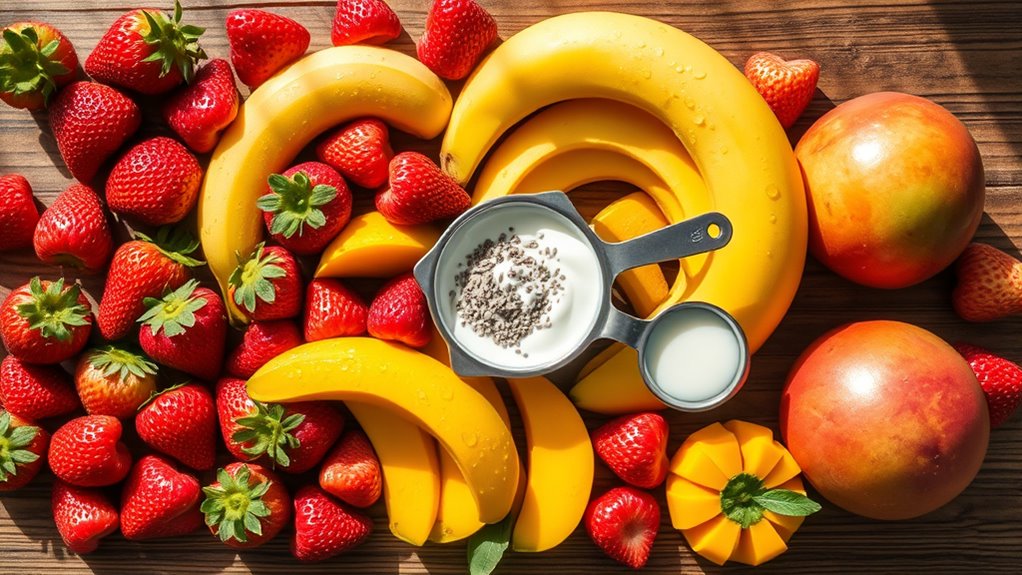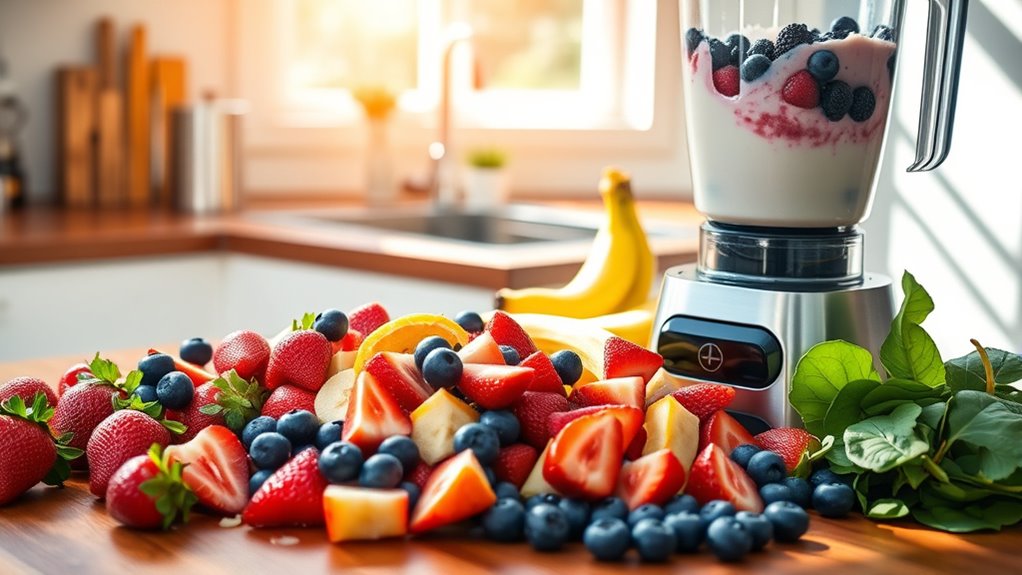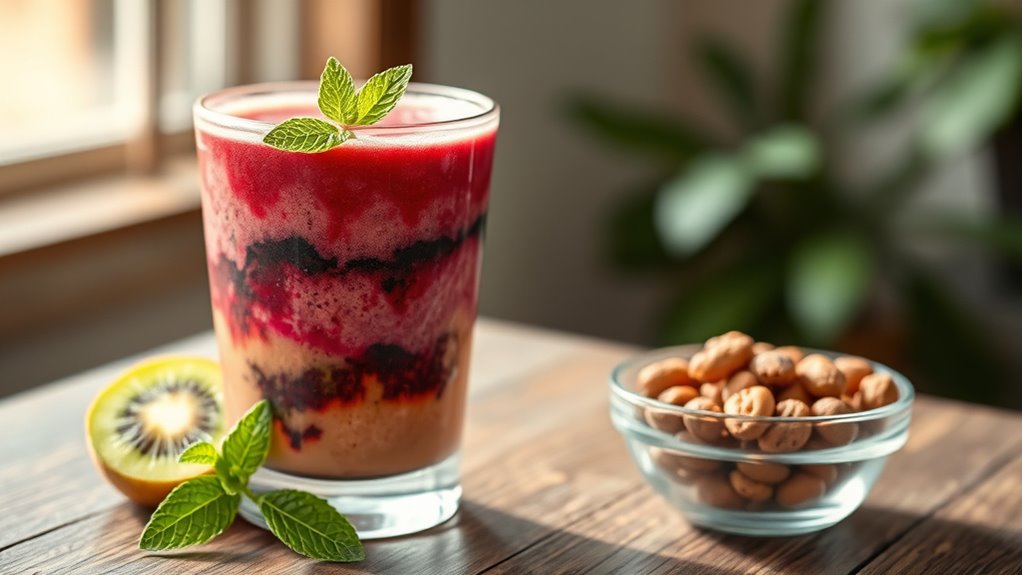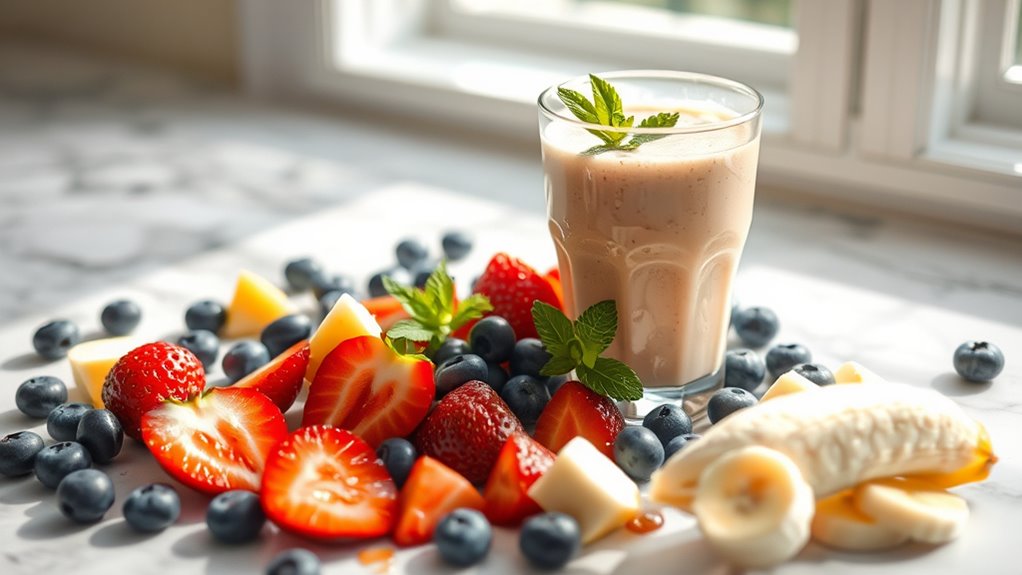You can create weight loss-friendly fruit smoothies by combining 3 to 5 nutrient-rich ingredients like berries, banana, and Greek yogurt in controlled portions. Start with washing and chopping fresh or frozen fruits, then blend them with liquids first for a smooth texture. Serve immediately in clear glassware to retain nutrients and add a protein source to boost fullness. Avoid sweetened yogurts or juices to limit calories. Keep following for tips to optimize flavor, texture, and nutrition.
Ingredients and Quantity

When preparing fruit smoothies, you’ll typically need a combination of three to five key ingredients to achieve the right balance of flavor and texture. Proper fruit selection guarantees you get essential vitamins, while portion control helps maintain calorie goals, aiding weight loss. Balancing fruits with liquids and protein sources creates a satisfying, nutrient-dense smoothie.
| Ingredient | Typical Portion | Purpose |
|---|---|---|
| Mixed Berries | 1 cup (150g) | Antioxidants, flavor |
| Banana | ½ medium (60g) | Creaminess, potassium |
| Greek Yogurt | ½ cup (120g) | Protein, texture |
Preparations

Before blending your smoothie, it’s essential to properly prepare each ingredient to maximize flavor and nutritional value. Start by washing fruits thoroughly to remove pesticides and bacteria. Peel and chop larger items into uniform pieces, which helps achieve a smooth texture. Freezing fruits beforehand not only preserves nutrients but also gives your smoothie a creamy consistency without added ice. Understanding different smoothie variations lets you tailor ingredient prep—like soaking nuts to soften them or using fresh versus frozen greens. Mastering blending techniques is equally important; begin with liquids and softer ingredients before adding denser components to guarantee even blending. This approach prevents clumping and enhances nutrient absorption, supporting your weight loss goals while offering the freedom to customize your smoothie efficiently and deliciously.
How to Prepare

- Select fresh or frozen fruits based on your preferred smoothie variations; frozen fruits often create a thicker texture, while fresh fruits offer a lighter consistency.
- Measure your ingredients precisely to maintain nutritional balance and support weight loss goals.
- Add liquids such as water, almond milk, or low-fat yogurt to the blender first to facilitate smooth blending.
- Layer fruits and other ingredients on top of the liquids to ensure even mixing.
- Use a high-speed blender to effectively break down fibers, enhancing nutrient absorption and texture.
- Pulse the blender initially to combine ingredients.
- Blend continuously until the mixture is smooth.
- Master these preparation steps and blending techniques to enjoy versatile, nutrient-rich smoothies that support a healthy lifestyle effortlessly.
How to Serve

Serving your fruit smoothie correctly can enhance both its flavor and nutritional benefits. Choosing the right presentation styles and serving suggestions lets you enjoy your smoothie while supporting your weight loss goals. Here are some practical ideas:
- Use clear glassware to showcase vibrant colors, boosting visual appeal.
- Serve immediately to preserve nutrients and freshness.
- Add a garnish like fresh mint or a slice of fruit for an inviting touch.
- Pair with a protein source, such as nuts or yogurt, to increase satiety.
- Opt for eco-friendly straws or no straw to align with sustainable habits.
These simple serving suggestions help you appreciate every sip, making your weight loss journey enjoyable and effective without compromising freedom or taste.
Tips

While blending your smoothie, you’ll want to balance texture and flavor by combining both soft and firm fruits, which helps create a satisfying consistency without needing added sugars. To support healthy habits, focus on including fiber-rich ingredients like berries or leafy greens, which aid digestion and promote fullness. Experimenting with smoothie variations—such as adding a handful of nuts or seeds—can boost protein and healthy fats, enhancing satiety. Avoid relying on fruit juices or sweetened yogurts, as these increase calorie intake without offering significant nutritional benefits. Planning your smoothies ahead allows you to control portions and ingredients, preventing impulsive choices. By incorporating these tips, you maintain freedom in your diet while optimizing weight loss and overall well-being through smart, evidence-based smoothie preparation.
Food Value and Benefit
Smoothies are a nutrient-packed prepared dish that combines whole fruits and vegetables to deliver a concentrated source of vitamins, minerals, fiber, and antioxidants. This recipe provides essential nutrients such as vitamin C, vitamin A, potassium, magnesium, and folate, making it a wholesome choice for any meal or snack.
Benefits of eating this smoothie recipe include:
- High fiber content promotes satiety and supports healthy digestion
- Antioxidants help reduce oxidative stress and inflammation
- Vitamins C and A boost immune function and skin health
- Potassium and magnesium aid in maintaining proper muscle and nerve function
- Natural sugars offer a steady source of energy without causing blood sugar spikes
- Hydrating fruits contribute to maintaining fluid balance in the body
